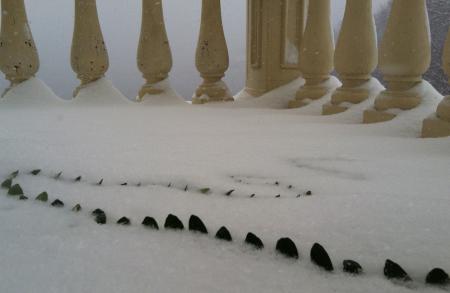Serendip is an independent site partnering with faculty at multiple colleges and universities around the world. Happy exploring!
nightowl's blog

Essay Rewrite #4
When I went to Zagar’s Magic Gardens, which is a concentrated space of his mosaics in one building, I was experiencing a form of escapism. The various details in the piece where too much too take in. The mosaic was made up of tiles, glass, found items, and homemade molds. A common theme was to have paint over the tiles, which outlined human forms and quotes about the city. The painted quotes often had misspelled words in them for example; “Forms are converes of meaning” In this quote “converes” might be converse, conveyers, or another word. Having this misspelling forces the quote to be open-ended and untranslatable.
I interpret the gardens as a space that welcomes you to be aware of your surroundings, but not necessarily to interpret or understand them. This is also true for natural gardens. Unlike other forms of art, people are often more willing to take form over interpretation when visiting a garden. This is facilitated by a garden being so large and detailed that it is nearly impossible to take in everything.
Looking at form is made easier in a garden because of its detachment from humans, which relieves the pressure for it to be useful or meaningful. Gardeners collect plants, arrange them in a space, and then let them grow and take root. Zagar is similar to a gardener in that he collects and organizes trash and then presents it in a space. The Magic Gardens are like a garden made of human trash, rooted in a city space.

Concrete and Abstract in Sonntag
I would say that in Sonntag’s essay anything concrete would mean an example or interpretation and abstract would be leaving the art alone with time and it’s physicality. Sonntag leaves parts of her essay open to interpretation in her use of sentence structure and words and what “new vocabulary” we would use to describe/define art. Instead of “genius” I would say as a “critic” that this is a lack of it, a lack of concrete ideas. I don’t like how she presents the abstract emotional side of art as indefinable. I think the emotional reaction that someone has to art is directly related to concrete ideas about the world. This as she says can constrain the artwork, but there are also multiple interpretations of art. Therefore, art mixed with time and multiple people has the potential to be interpreted in almost everyway. This basically infinite amount of interpretations is how I think of the abstract emotional side of the art. I think that interpreting isn’t altering something but is taking from it something that is already there whether the artist knew they put it there or not.

Would Barnes collect the new Barnes Foundation as a piece of artwork?
In order to read my experience of The Barnes Foundation as a piece of artwork through the lens of Barnes’s ideology, I can consider the time, access system, colors, architecture, people and artwork found in the building. I am thinking of what the space invites me to think as a piece of artwork in itself.

Barnes as a Piece
When I went to the Barnes I was attracted to my painting because of the sense of joyful movement that it gave me. I would like to think of this first attraction as an “esthetic” experience, which I managed to have in an environment that was not how Barnes originally intended. Even in an overcrowded room with upper-class people, encapsulated in a modern box and in a nice neighborhood the art was not completely stripped of its potential to allow people to think in some of ways that Barnes planned. After Barnes’s death I don’t think either location would ever have attracted a crowd that wasn’t skewed towards upper class, especially considering that the old Barnes was located in a rich neighborhood. In my revision I want to look at the new Barnes as a pieces of artwork in itself and try to read it using Barnes’s principals.

The Ribalds Daumier
The lack of features in the face of the woman in the forefront of this painting is what I first noticed. I kept looking because of the rough indents in her face alluded to what she might look like, they reminded me of festive movement. I think one possible reason for the lack of facial detail is that she is in movement. She appears to be either dancing or greeting someone. There is a second woman next to her that has her arm raised with her fingers spread. This pose could be one of greeting or a dance movement. The woman in the forefront further supports the idea that it is a greeting by looking at the general direction of the waving hand. She is also holding an object that resembles a book; it looks like she has stuck her thumb inside of a page to keep it open. This implies that she had recently stopped reading in order to wave at someone or dance.

Borders, Deep and Critical Play
I think 17 Border Crossings had the greatest potential for deep play at the end when Pablo was crossing. That moment was not meant to make us laugh, but to have us be internally emotional. Everything else in the play felt more like examples that were humorous critical play. I think a lot of the time critical play leads to deep play and the live creature. The live creature almost seems like the emotional side of critical play, in that the live creature has more to do with being aware about the facts in your surroundings. Then deep play seems like you are more aware through emotions than facts.

Deep Play
It is the middle of summer at music camp. About 60 instruments are outside soaking in the open muggy air, wood expanding, and increasing their potential to crack. Before my quartet walks onto stage, we notice that our quartet teacher had somehow obtained our music and drawn cats and smiley faces all over it. This was supposed to encourage us to smile and interact more as we play. Once we had all sat down, adjusted our music, and right before we were about to play, we all turned to our teacher in the audience and forcibly smiled and purred at her. The next moment we started playing. All of us went in a circle and played our opening solos, we looked at each other right before our cues, and when we had parallel lines. The technical aspects of how to play were gone, and we connected by talking to each other through listening to each other’s music and responding.
From the audience’s perspective our quartet probably looked strange, smiling and making noises at the crowd before playing, and the way we played compared to a professional recording of Beethoven was not impressive. Then from a further removed perspective, playing quartets serves no practical purpose in the sustainment of life. However, from the inside, this moment was really moving to me because of the connection I made with my quartet members and the music.

Resocialization
Anne Birk is a Danish criminologist who says that the purpose of Danish prisons “is not to make the inmates’ lives as miserable as possible. Instead, Danish prisons strive for the goal of normalization. The prisons are designed to closely resemble life on the outside,” an idea she calls “re-socialization.” (Toll) The normalization in these prisons, “is not about normalizing the prisoner; it is about normalizing the prison conditions.” (Toll) American prisons have almost ten times the amount of prisoners that Denmark has. (International) It is estimated that tens of thousands of these American prisoners are in solitary confinement. (Goode) Solitary confinement supposed purpose is to confine uncontrollable prisoners, but in many cases those prisoners would function equally as well in less controlled environments. In fact, “isolation [is] likely to produce mental illness as remorse.” (Goode) This makes isolation itself a perpetuator of isolation, “If you treat people like animals, that’s exactly the way they’ll behave.” (Goode)
American prisons should restrict inmates in the same way citizens are restricted when they function in society. Isolation by its nature does not provide any form of “re-socialization” (Toll), and only encourages the prisoner to reach more into themselves instead of a community.




